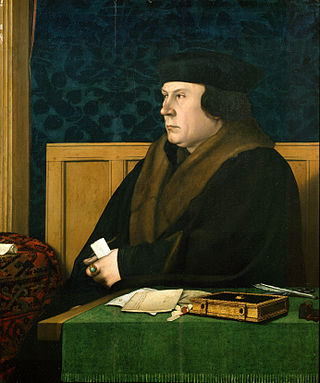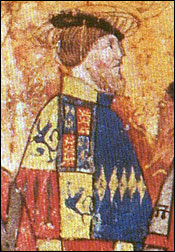Related Research Articles

Thomas Cromwell, briefly Earl of Essex, was an English statesman and lawyer who served as chief minister to King Henry VIII from 1534 to 1540, when he was beheaded on orders of the king, who later blamed false charges for the execution.

Thomas Howard, 3rd Duke of Norfolk, was a prominent English politician and nobleman of the Tudor era. He was an uncle of two of the wives of King Henry VIII, Anne Boleyn and Catherine Howard, both of whom were beheaded, and played a major role in the machinations affecting these royal marriages. After falling from favour in 1546, he was stripped of his dukedom and imprisoned in the Tower of London, avoiding execution when Henry VIII died on 28 January 1547.

George Boleyn, Viscount Rochford was an English courtier and nobleman who played a prominent role in the politics of the early 1530s as the brother of Anne Boleyn, second wife of King Henry VIII. George was the maternal uncle of Queen Elizabeth I, although he died long before his niece ascended the throne. Following his father's promotion in the peerage in 1529 to Earl of Wiltshire and Earl of Ormond, he adopted his father's junior title Viscount Rochford as a courtesy title. He was accused of incest with his sister Anne during the period of her trial for high treason, as a result of which both were executed.
John Barlow was a member of Henry VIII's Protestant Church as Dean of Worcester Cathedral. During the king's search for an annulment to his first marriage, Barlow acted as a courier between England and Italy, while Rector of Hever.

Henry Percy, 6th Earl of Northumberland, KG was an English nobleman, active as a military officer in the north. He is now primarily remembered as the betrothed of Anne Boleyn, whom he was forced to give up before she became involved with and later married King Henry VIII.
John Palsgrave was a priest of Henry VIII of England's court. He is known as a tutor in the royal household, and as a textbook author.
Henry Norris was an English courtier who was Groom of the Stool in the privy chamber of King Henry VIII. While a close servant of the King, he also supported the faction in court led by Queen Anne Boleyn, and when Anne fell out of favour, he was among those accused of treason and adultery with her. He was found guilty and executed, together with the Queen's brother, George Boleyn, Sir Francis Weston, William Brereton and Mark Smeaton. Most historical authorities argue that the accusations were untrue and part of a plot to get rid of Anne.

Sir Thomas Arundell of Wardour Castle in Wiltshire was a Cornish administrator and alleged conspirator.
Events from the 1530s in England.
Sir William Boleyn, KB of Blickling Hall in Norfolk and Hever Castle in Kent, was a wealthy and powerful landowner who served as Sheriff of Kent in 1489 and as Sheriff of Norfolk and Suffolk in 1500. He was the father of Thomas Boleyn, 1st Earl of Wiltshire, whose daughter was Queen Anne Boleyn, the second wife of King Henry VIII.

Sir Geoffrey Boleyn was an English merchant and politician who served as Lord Mayor of London from 1457 to 1458. He purchased the manor of Blickling, near Aylsham, in Norfolk from Sir John Fastolf in 1452, and Hever Castle in Kent in 1462. He was the great-grandfather of Queen Anne Boleyn, the mother of Queen Elizabeth I. Sir Geoffrey built the domestic, mercantile and civic fortunes of the Boleyn family, and raised its status from the provincial gentry, as his brother Thomas Boleyn made a career of distinction in church and university, together building the family's wealth, influence and reputation.
Anne, Lady Shelton née Boleyn was a sister of Thomas Boleyn, 1st Earl of Wiltshire, and one of the aunts of his daughter, Queen Anne Boleyn, the second wife of King Henry VIII.
Thomas Wynter or Winter was the Archdeacon of York, Richmond, Cornwall, Provost of Beverley, Dean of Wells Cathedral and the illegitimate son of Cardinal Thomas Wolsey.
Elizabeth, Lady Boleyn was a lady-in-waiting at the court of Henry VIII of England. Through her marriage to Sir James Boleyn, she was the aunt of Henry VIII's second wife, Anne Boleyn. The two were not close, and Elizabeth Boleyn acted as her niece's gaoler when Queen Anne was arrested on charges of adultery, incest and conspiracy to kill the King.
Richard Layton or Leighton (1500?–1544) was an English churchman, jurist and diplomat, dean of York and a principal agent of Henry VIII and Thomas Cromwell in the Dissolution of the Monasteries.
Joan Larke was the mistress of the powerful English statesman and churchman in the Tudor period, Thomas Wolsey, Archbishop of York, and mother of his two illegitimate children.

Anne Gainsford, Lady Zouche was a close friend and lady-in-waiting to Queen consort Anne Boleyn.
Lieutenant Admiral Sir William Woodhouse was an English naval commander and administrator who rose to the rank of Lieutenant of the Admiralty and was head of the Council of the Marine later called the Navy Board. He also served as a Member of Parliament of the Parliament of England from 1545 to 1564. He was prominent during an important time of the Navy Royal's development in the later half of the Tudor period.
Edmund Steward otherwise Stewart or Stewarde was an English lawyer and clergyman who served as Chancellor and later Dean of Winchester Cathedral until his removal in 1559.
Sir John Spelman was an English judge from Norfolk, noted for his composition of law reports.
References
- 1 2 3 4 "Boleyn, William". ACAD Venn Cambridge Alumni Database. 2021. Retrieved 20 June 2024.
- ↑ Jones, B (1963). Fasti Anglicanae 1300 - 1541 Vol. 6 Northern Province.
- 1 2 3 4 5 Payne, Andrew (2022). "William Boleyn Winchester's Absentee Archdeacon". Proceedings of the Hampshire Field Club & Archeological Society. 77: 104–110.
- ↑ Brewer, J.S., ed. (1875). Letters and Papers, Foreign and Domestic, Henry VIII, Vol. 4 1524-1530. HMSO. p. 2730.
- ↑ Madge F.T. & Chitty H (1926). Registrum Thome Wolsey Cardinalis Ecclesiae Wintoniensis Administratoris. Oxford University Press.
- ↑ Hampshire Record Office 21M65/B1/4-7
- 1 2 Chitty, Herbert (1930). Registra Stephani Gardiner et Johannis Poynet Episcoporum Wintoniensium. Oxford University Press.
- ↑ Valor ecclesiasticus temp. Henr.VIII: Auctoritate regia institutus Vol. II. London. 1814.
- ↑ Gairdner, J., ed. (1886). Letters and Papers, Foreign and Domestic, Henry VIII, Vol.9 August - December 1535. HMSO. p. 78.
- ↑ Blomefield, F (1805). An Essay Towards a History and Topograhical Survey of Norfolk Vol. 6. pp. 268–285.
- ↑ Blomefield, F (1805). An Essay Towards a History and Topographical Survey of Norfolk Vol. 6. pp. 374–381.
This article needs additional or more specific categories .(September 2024) |